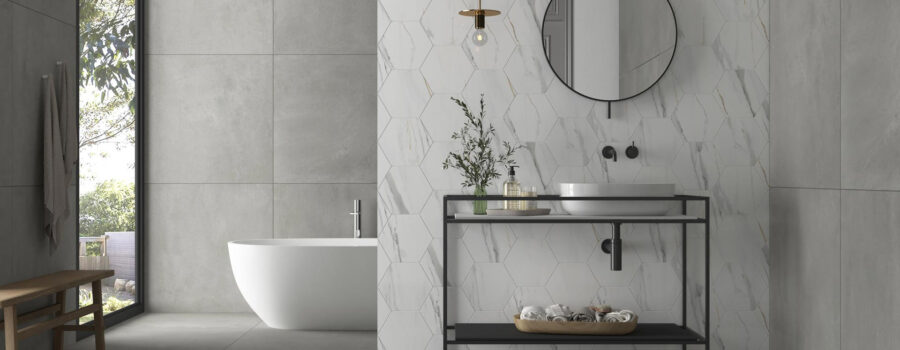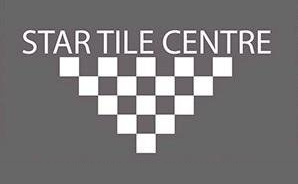Ceramic/porcelain tile and natural stone materials have been used for centuries as a flooring surface. Ceramic/porcelain tile has grown to be the surface of choice for many Canadian homes, and for good reason. Its ease of maintenance and the selection available today offer the consumer a limitless range of possibilities.
The huge selection of sizes and accent pieces now available in ceramic/porcelain floor and wall tiles allow the professional tile salesperson the opportunity to help give each and every home a distinctive design.
The trend today is moving toward larger sizes that reflect the latest in technology. The “tumbled” marble look can now be achieved with ceramic/porcelain tile, which is one of the latest looks to hit the North American market. The latest trends in flooring show natural colours and lots of textures. People have a selection such as they’ve never had before. Colours today lean toward warm colours — honey beiges and terracottas — but the accent colours have changed. Now, we’re seeing rich blues, natural greens, deep mustards, and pewter shades.
Ceramic/porcelain tile, if purchased and installed correctly, offers a permanent flooring solution to the homeowner. When purchasing tile, however, there are several areas that should be considered, before parting with your hard-earned money.
Don’t sacrifice quality design and craftsmanship to save a bit of cash. Cheap tile, for example, in a high traffic area can quickly show wear and tear and may cost you more in the long run to replace it.
Design of the Tile
Today, more than ever before, the homeowner can achieve a personalized, creative ceramic tile design. The use of listellos (accent strips), fascias (hand-painted border pieces), and decorative inserts allow the purchaser to reflect a dramatic statement or casual elegance to their overall decor.
The range of colours now available cover the full spectrum of the rainbow. Whether seeking a practical solution or a bold statement, the wide variety of textures, colours, custom decors, sizes, installation techniques, and patterns are sure to be available for your discerning final selection. There has been a resurgence of glass mosaics which are a very popular choice of designers for kitchen backsplashes, bathroom walls and countertops and even as accents on floors.
Quality of Tile
Ceramic/porcelain floor tiles are rated on two scales, which are internationally recognized. Firstly, they are rated on a PEI scale, which rates the tile from 1 to 5 for wear resistance, with 5 being the most resilient. Ideally, your heavier traffic areas, such as kitchens and family rooms, should be a 4 or 5. A tile with a PEI of 5 is rated for heavy commercial use, and a PEI of 4 for moderate commercial use or heavy residential traffic. Bathrooms or laundry rooms would be perfectly suited for a tile with a PEI of 3. Tiles with a PEI of 1 or 2 should not be considered for floor applications. The second scale used is the MOHS scale, which rates tiles for surface hardness on a scale of 1 to 10, with 10 being comparable to the resilience of a diamond. Most floor tiles will be rated from 4 to 8. Become familiar with these terms and be sure to ask for these ratings when shopping for tile. Remember, you are going to be living with your new floor for a long time, and it’s important to make an informed decision.
Like any product, price will be an obvious factor in helping determine your final selection. But do keep in mind that it costs no more to install a superior tile than an inferior one. However, the replacement costs might prove staggering.
Types of Tile
The following is a small sampling of the many styles available today:
Mexican Saltillo Paver: These are natural clay tiles from northern Mexico, hand-made, sun-baked, and kiln-fired. They are beautiful sunwashed terracotta, ranging in shades from burnished reds to muted yellows. Due to their handmade quality, sizing will vary from tile to tile, and edges may be less than square. They are available pre-sealed, or can be sealed at the time of installation. A multitude of sizes are available: 16” x 16”, 12” x 12”, 8” x 8”, hexagons, octagons, and more.
Metallic Finishes are available in 24” x 24” sizes down to 5/8” mosaic. Sleek, futuristic, fashionable, matte, hammered and texturized finishes available. They create a warm, rustic look – perfect for century-old homes and new homes alike.
Stone Look Tiles: These are available in 24” x 24”, 20” x 20”, 18” x 18”, 16” x 16”, 12” x 12”, and modular complimentary sizes to allow you to combine the sizes into a variety of installations, or match your countertop or
kitchen backsplash to the floor. They provide you with a gorgeous natural stone-looking floor without the care, maintenance, or cost of a natural stone. These tiles will vary in shade from tile to tile to provide an effective imitation of Mother Nature’s marble, slate, and limestone. Be sure to ask your sales consultant to view several pieces of the tile before installation to be sure of the full range of colour.
Marble Look: Available today in gloss and non-slip textures, the marble look remains one of the most popular styles in ceramic/porcelain floor and wall tiles. The newer tiles are very muted, reminiscent of the worn marble floors of Venice and Florence. The influences are more rustic, more natural, and more classic for today’s decor.
Wall Tiles: Available in larger and larger sizes today, for easy maintenance (less grout to clean), and cleaner visual lines. Hand-painted accent pieces and listellos are available, or you can have a local artist custom paint decorative tiles or a small mural to perfectly compliment your decor. The colours, shapes, and designs are yours for the asking. The possibilities are endless.
Kitchen Backsplash Tiles: Brighten up that space between your countertop and cabinets with a multitude of choices — from 4 x 4 glass-glazed tiles in a rainbow of colours to a rustic, tumbled marble. It’s not a large space, so don’t be afraid to spend some time putting together the perfect compliment to your kitchen. Ceramic/porcelain tile is ideally suited for this space — no matter what is splattered on the tile, simply wipe it down. Natural stones should be sealed to eliminate their porosity.




















